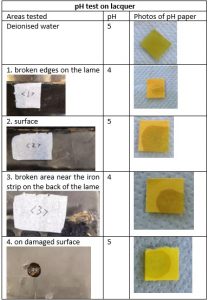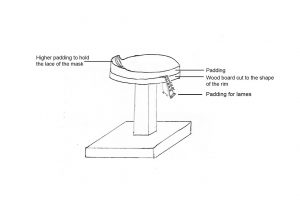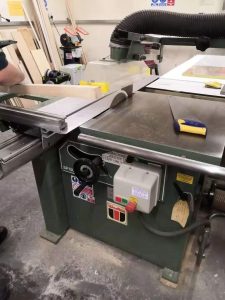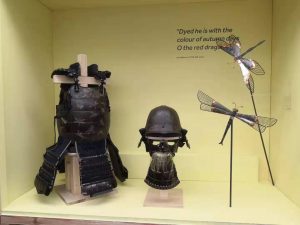Samurai Armour – Student Placement Post

Hello, I am Liuyi, a Durham conservation student, currently on placement in Manchester Museum. At the beginning of my placement, I received a big task: prepare an object for the upcoming-exhibition Beauty and the Beasts (November 2019 to November 2020). The exhibition is all about the beauty of insects and the importance of insects in our world.

The object I got is a suit of Japanese armour, including the cuirass, helmet and mask. It is a composite object that has horizontal lames of lacquered metal, watered steel cuirass (do) and silk braids that bond every piece together. The cuirass is decorated by silver and gold inlays in the shape of six different kinds of insects and animals: dragonfly, dragon, long-horned beetle, gecko, butterfly and frog. They are symbols of Japan herself, and strength, courage and victory to Samurai warriors. More interestingly, we can find several musket shots in the front and back of the armour. The shots confirm that the armour had been used.

Overall, the armour is in a fair condition. The pH test of the lacquer indicates that the lacquer on the object is relatively stable. In some area, the lacquer layer detached and cracked due to the deformation of the substrates. They were consolidated with 20% Paraloid B72 in acetone and white spirit.

The metals are all relatively stable. Thus, only basic surface cleaning was applied. For iron, a soft brush and vacuum were used. For silver and gold, ethanol and cotton swabs were used.


Most of textiles are in good condition, but fragile. Some of the silk braids that were under stress are broken. However, after consulting the textile conservator, Ann French from the Witworth Gallery, it was decided, after cleaning, that a more thoroughly designed preventive conservation treatment should be applied to the object rather than interventive conservation: a more supportive mount needed to be made for the object. According to Ann, a well-designed mount would be more important than interventive conservation, especially for textile deterioration caused by stress.

Therefore, two mounts were designed according to traditional Japanese armour mounts and requirements of display and conservation. They were padded with plastazote covered with dyed-black fabric and secured to the mount by stitching a piece of Velcro to the underside, which was attached to another piece of Velcro that had been nailed to the wood of the mount. All the lames on the cuirass and helmet are also held by the padding, secured by metal rods attached to the wooden panel that supports the lower edge of cuirass. This will help reduce the stress on the silk braids of the lames.



During the mount-making process, the museum senior technician John Miller helped me make the mounts. I also tried different kinds of working machines in the workshop which was great fun and valuable experience.

After one and a half month’s hard working, the exhibition opened on time. When I put the Japanese armour in the display case, I felt so happy as it was the very first object that I conserved in my placement at Manchester Museum.

From this project, I have learnt how important preventive conservation is. Although it is not a direct way of treating an object, it still can have a great impact on the objects. When we think about minimal intervention, think more about the preventive way of conserving objects, and remember good mounting is as important as environment control. A well-designed mount may be a good alternative for consolidation or reinforcement.

Liuyi
